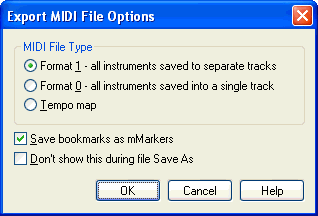|
L'aide française est disponible au format PDF en cliquant ici (ou dans le Menu "Démarrer", Finale 2010, Documentation PDF française)
Le tutoriel français est disponible au format PDF en cliquant ici.
La mise à jour de l'aide française au format HTML sera disponible prochainement.
|
Traduction française :

|
Export MIDI File Options dialog box

How to get there
Choose Export MIDI File Options from the MIDI/Audio menu.
Or,
Choose Save As from the File menu. Enter a title and select MIDI File from the File Type drop-down list. Click OK.
Also, when you save a MIDI File from the Playback Controls, the MIDI File Options dialog box appears when you click OK.
What it does
You can save any document into several formats. This file format, known as a standard , enables your document to be shared with other music programs (primarily sequencers), most of which can read this kind of file.
In this dialog box, Finale asks you which kind of MIDI file you want to create; most sequencers can read any of these formats.
The MIDI File Options dialog box also lets you save bookmarks as markers when you create a MIDI file.
- MIDI File Type: Format 1. Click this button to create a Format 1 MIDI file—by far the most widely used format, which contains multiple tracks. In Finale, every Instrument is placed in its own track; remember that each element of each staff (Layer 1–4, Chords, and Expressions) can have its own Instrument assignment. Remember, too, that unless you’ve given each of these elements its own Instrument, the resultant MIDI file won’t have multiple tracks. For a discussion of Instruments, see Instrument List.
- MIDI File Type: Format 0. In this MIDI file format, all of the music is placed in a single track, separated only by MIDI channel. In Finale, however, two staves can only have different MIDI channel assignments if they also have different Instrument assignments. So, again, for the purposes of this file format, make sure you’ve assigned a different Instrument to every element (Layer 1–4, Chords, Expressions) you want assigned to its own MIDI channel.
- MIDI File Type: Tempo Map. Certain advanced sequencer programs allow you to import a tempo map of a piece—that is, a separate file consisting entirely of the ritards, accelerandi, and other tempo fluctuations in a piece. Click this button to create a Tempo Map MIDI file from your document.
- Save Bookmarks as Markers. Specify whether you’d like the Finale bookmarks converted to sequencer marks.
- Don’t show this during File Save As. Select this option if you wish to use the current settings in the Export MIDI File options next time you save a MIDI file in Finale. The Export MIDI File Options dialog box will not be displayed when you save a MIDI file, only when Export MIDI File Options is selected from the MIDI/Audio menu. Deselect this checkbox to again display the Export MIDI File Options dialog box when saving MIDI files.
- OK • Cancel. Click OK to confirm, or Cancel to return to the score without creating a MIDI file.
See Also:
MIDI
Instrument List
MIDI/Audio menu


